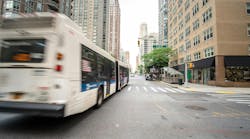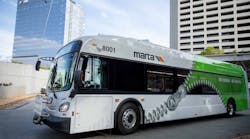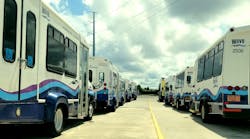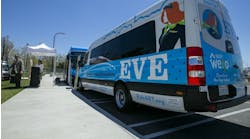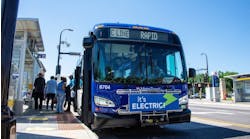The bus continues to be the workhorse of the transit industry. New bus projects to enter revenue service during the past year include C-TRAN’s Mill Plain Bus Rapid Transit (BRT), Capital District Transportation Authority’s BusPlus Purple Line BRT, EMBARK’s inaugural RAPID line and Community Transit’s Swift Orange Line. The mode is experiencing general ridership return at a faster rate than other modes and it’s driving the industry’s movement toward lower and zero emissions. This report is designed to provide a snapshot of what is occurring in the bus market through recent news and data analysis.
A policy brief released in December 2023 from the American Public Transportation Association (APTA) offers a national view of ridership trends in the U.S. Overall, transit ridership has reached more than 77 percent of pre-pandemic levels, which is a significant gain when compared against the lowest levels that represented 20 percent of pre-pandemic ridership. While the job market and return to office polices have helped transit ridership recovery, office occupancy rates have slowed while ridership continues to increase, indicating the attraction of transit for non-commute trips.
The APTA brief explains bus ridership has consistently led other modes in ridership recovery “due to bus rider population groups,” which include riders under 25 and those who work in non-office jobs.
The brief concludes that agencies focused on serving historically marginalized communities could see ridership growth. This includes support for hourly, late night and early morning workers by reinvesting in equitable transit. Additionally, the brief explains real estate investment in central-city areas could potentially further an increase in ridership.
Another recent development impacting transit vehicles, in particular rubber-tired vehicles, is the publication at the end of March of the Environmental Protection Agency’s (EPA) final rule on Greenhouse Gas Emissions Standards for Heavy-Duty Vehicles-Phase 3. The rule phases in standards for heavy-duty vehicles, including transit and shuttle buses, over Model Years (MY) 2027 through 2032. EPA says standards are technology-neutral and performance-based, allowing each manufacturer to choose what set of emissions control technologies is best suited for them and the needs of their customers. The agency also explained the standards can be met through a variety of vehicle models, including advanced internal combustion engine vehicles, hybrid vehicles, plug-in hybrid electric vehicles, battery electric vehicles and hydrogen fuel cell vehicles.
For heavy-duty transit vehicles, the Phase 3 standards in the final rule are 13 percent stronger than Phase 2 starting in MY 2029 and increase to 30 percent stronger in MY 2032.
EPA says the standards will avoid 1 billion tons of greenhouse gas emissions and provide $13 billion in annualized net social benefits related to public health, the climate and savings for fleet owners and operators.
The final rule includes analysis of costs under the new standards, including costs per mile, as well as maintenance and repair costs. The EPA final rule estimates fuel cost per mile for MY 2032 vehicles from calendar years 2023 to 2055 will range from 20.2 cents/mile to 38.2 cents/mile for diesel urban buses, 8.5 cents/mile to 16 cents/mile for electric buses and 23.2 cents/mile to 43.9 cents/mile for compressed natural gas (CNG) buses.
EPA estimates the maintenance and repair cost per mile for the same model years as above will range from 13.6 cents/mile to 29.9 cents/mile for diesel and CNG buses and 9.7 cents/mile to 21.2 cents/mile for electric buses.
Continuing move to zero emissions
While EPA stressed flexibility among a variety of vehicle models as a key component to its new standards, the transit industry has been strengthening its commitment to transition toward lower-emission and zero-emission buses (ZEBs).
In Mass Transit’s recent “2024 Mobility Outlook” survey, 49 percent of respondents answered their agency planned to award a battery electric bus contract in 2024, 10 percent reported that a fuel cell electric bus (FCEB) contract would be awarded this year and 16 percent reported a contract for diesel vehicles would be awarded.
CALSTART, which produces an annual report tracking the adoption of zero-emission vehicles, said transit agencies in the U.S. and Canada “made steady, measurable strides in transitioning their fleets to zero-emission buses” during the past year.
CALSTART’s “2024 Zeroing in on ZEBs” report determined the total count of full-size battery-electric and fuel-cell electric transit buses in the U.S. has grown to 6,147 as of September 2023, which is a 12 percent increase compared to 2022. The total count of small ZEBs deployed in the U.S. number 1,010, which is a 15 percent increase compared to 2022.
Canada has also experienced year-to-year growth in full-size and small ZEB adoptions. As of September 2023, the number of ZEBs across the country has grown to 976, with ZEBs found in eight of the country’s 10 provinces. Data analysis from the Canadian Urban Transit Research and Innovation Consortium (CUTRIC) found the country has 2,144 ZEBs in the funding, procurement, commissioning or in-service stages of fleet transition. CUTRIC’s analysis also determined Canda would achieve its goal of introducing 5,000 ZEBs by 2026.
CALSTART notes the North American ZEB fleet consists primarily of battery-electric vehicles, with a total of 419 fuel cell electric buses – 381 vehicles in the U.S. and 38 in Canada – deployed as of September 2023.
In the U.S., leaders at SunLine Transit Agency have been open about the challenges faced with its hydrogen fueling station, which has been unable to supply SunLine with the hydrogen needed to operate its fleet of FCEBs. The agency is leasing CNG vehicles as a short-term solution and began construction on a new liquid hydrogen station to build resilience into its hydrogen program. In Canada, CUTRIC explains FCEBs carry challenges, including a higher procurement cost and costs associated with their operations and maintenance, the lack of Canadian best practices for hydrogen-powered transit buses and a lack of smaller to medium vehicle options for FCEBs.
Respondents to Mass Transit’s “2024 Mobility Outlook” survey said the availability of federal funds was a top influencing factor in their pursuit of low- or no-emission fleets. The CALSTART and CUTRIC reports also note the important role funding availability plays in the transition of fleets. CUTRIC called the 2021 Zero Emissions Transit Fund a “paradigm shift” for Canadian agencies working to transition their fleets. The fund, along with Canada Infrastructure Bank’s Zero Emission Bus Initiative, is supporting 6,500 ZEB acquisitions.
In the U.S., the Federal Transit Administration’s (FTA) Low or No Emission Bus Program and Buses and Bus Facilities Competitive Program awarded a combined $1.7 billion in grants to support 690 ZEBs. Additionally, the two programs awarded a combined $342 million to projects involving infrastructure to support zero-emission projects. In February, FTA made $1.5 billion available through the two programs for the Fiscal Year 2024 funding round.


